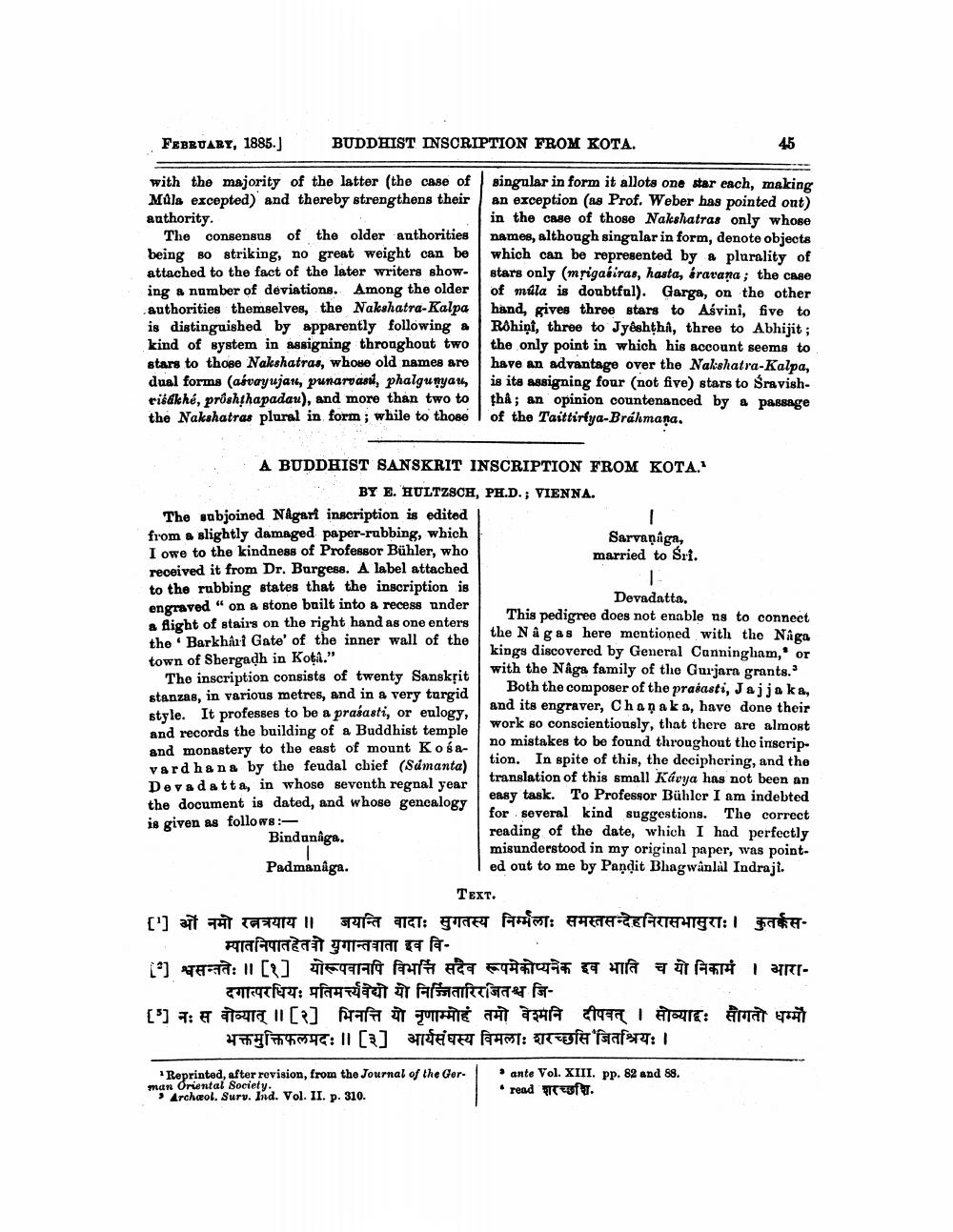________________
FEBRUARY, 1885.]
BUDDHIST INSCRIPTION FROM KOTA.
45
with the majority of the latter (the case of Mals excepted) and thereby strengthens their authority
The consensus of the older authorities being so striking, no great weight can be attached to the fact of the later writers showing a number of deviations. Among the older authorities themselves, the Nakshatra-Kalpa is distinguished by apparently following a kind of system in assigning throughout two stars to those Nakshatras, whose old names are dual forms (asvayujati, punarvasil, phalgunyarby ciedkhé, průshthapadau), and more than two to the Nakshatras plural in form; while to those
singular in form it allots one star each, making an exception (as Prof. Weber has pointed ont) in the case of those Nakshatras only whose names, although singular in form, denote objects which can be represented by a plurality of stars only (mrigabiras, hasta, árarana; the case of mula is doubtfal). Garga, on the other hand, gives three stars to Asvini, five to Rəhiņi, three to Jyêshthi, three to Abhijit; the only point in which his account seems to have an advantage over the Nakshatra-Kalpa, is its assigning four (not five) stars to Sravishthâ; an opinion countenanced by a passage of the Taittirfya-Brákmaņa.
A BUDDHIST SANSKRIT INSCRIPTION FROM KOTA."
BY E. HULTZSCH, PH.D.; VIENNA. The subjoined Någari inscription is edited from a slightly damaged paper-rubbing, which
Sarvaņaga, I owe to the kindness of Professor Bühler, who
married to Sri. received it from Dr. Burgess. A label attached to the rubbing states that the inscription is engraved" on a stone built into a recess under
Devadatta.
This pedigree does not enable us to connect a flight of stairs on the right hand as one enters the Barkhai Gate' of the inner wall of the
the Nagas here mentioned with the Naga
kings discovered by General Canningham,' or town of Shergadh in Koti." The inscription consists of twenty Sanskrit
with the Naga family of the Gurjara grants. stanzas, in various metres, and in a very turgid
Both the composer of the prasasti, Jajjaka, style. It professes to be a prasasti, or eulogy,
and its engraver, Chanaka, have done their and records the building of a Buddhist temple
work so conscientiously, that there are almost and monastery to the east of mount K osa
no mistakes to be found throughout the inscripvardhana by the feudal chief (Samanta)
tion. In spite of this, the deciphering, and the Devadatta, in whose seventh regnal year
translation of this small Kávya has not been an the document is dated, and whose genealogy
easy task. To Professor Bühler I am indebted is given as follows:
for several kind suggestions. The correct Bindanaga.
reading of the date, which I had perfectly
misunderstood in my original paper, was pointPadmanaga.
led out to me by Pandit Bhagwanlůl Indraji.
Text. [१] ओं नमो रत्नत्रयाय ॥ जयन्ति वादाः सुगतस्य निर्मला: समस्तसन्देहनिरासभासुराः। कुतर्कस.
म्पातनिपातहेतबो युगान्तवाता इव वि. I'] : [] era a ACE 4* Hoa Taqat ATÉ 1 apri
दगारपरधियः प्रतिमर्त्यवेद्यो यो निजितारिरजितश्च जि[5] T: DITT 11C] are o pHÉ H A 1977 I : Amat pent
4 4 4: 11 [3] Mere HT: Tegfe'fsafry: 1
Reprinted, after revision, from the Journal of the Gor man Oriental Society.
» Archæol. Surv. Ind. Vol. II. p. 310.
a nte Vol. XIII. pp. 82 and 88. read Trefu.




